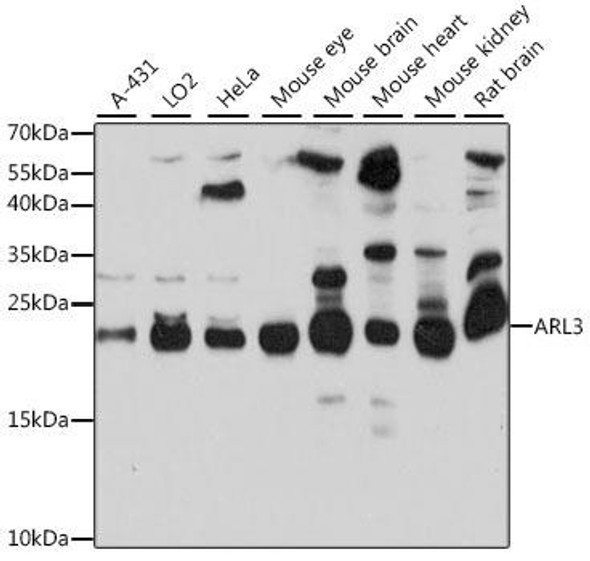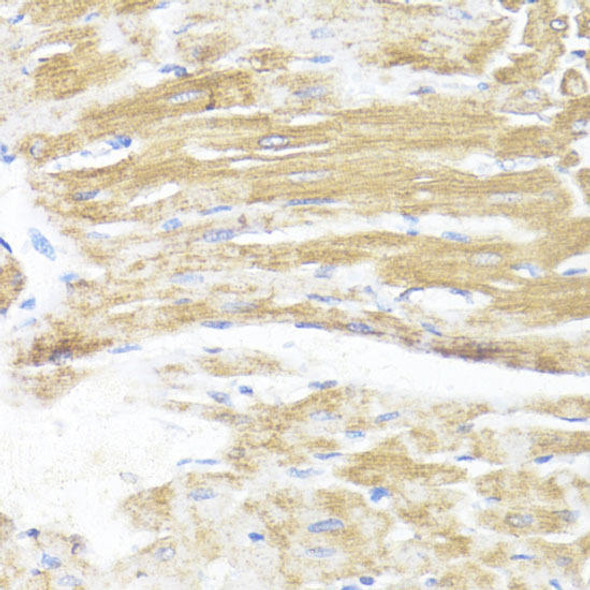Cell Biology Antibodies 7
Anti-RASA1 Antibody (CAB1634)
- SKU:
- CAB1634
- Product Type:
- Antibody
- Reactivity:
- Human
- Reactivity:
- Mouse
- Reactivity:
- Rat
- Host Species:
- Rabbit
- Isotype:
- IgG
- Antibody Type:
- Polyclonal Antibody
- Research Area:
- Cell Biology
Description
| Antibody Name: | Anti-RASA1 Antibody |
| Antibody SKU: | CAB1634 |
| Antibody Size: | 20uL, 50uL, 100uL |
| Application: | WB |
| Reactivity: | Human, Mouse, Rat |
| Host Species: | Rabbit |
| Immunogen: | Recombinant fusion protein containing a sequence corresponding to amino acids 140-220 of human RASA1 (NP_002881.1). |
| Application: | WB |
| Recommended Dilution: | WB 1:500 - 1:2000 |
| Reactivity: | Human, Mouse, Rat |
| Positive Samples: | Mouse testis, Rat testis |
| Immunogen: | Recombinant fusion protein containing a sequence corresponding to amino acids 140-220 of human RASA1 (NP_002881.1). |
| Purification Method: | Affinity purification |
| Storage Buffer: | Store at -20'C. Avoid freeze / thaw cycles. Buffer: PBS with 0.02% sodium azide, 50% glycerol, pH7.3. |
| Isotype: | IgG |
| Sequence: | PPYL PPLG AGLG TVDE GDSL DGPE YEEE EVAI PLTA PPTN QWYH GKLD RTIA EERL RQAG KSGS YLIR ESDR RPGS FVLS F |
| Gene ID: | 5921 |
| Uniprot: | P20936 |
| Cellular Location: | Cytoplasm |
| Calculated MW: | 58kDa/100kDa/101kDa/116kDa |
| Observed MW: | 125kDa |
| Synonyms: | RASA1, CM-AVM, CMAVM, GAP, PKWS, RASA, RASGAP, p120, p120GAP, p120RASGAP |
| Background: | The protein encoded by this gene is located in the cytoplasm and is part of the GAP1 family of GTPase-activating proteins. The gene product stimulates the GTPase activity of normal RAS p21 but not its oncogenic counterpart. Acting as a suppressor of RAS function, the protein enhances the weak intrinsic GTPase activity of RAS proteins resulting in the inactive GDP-bound form of RAS, thereby allowing control of cellular proliferation and differentiation. Mutations leading to changes in the binding sites of either protein are associated with basal cell carcinomas. Mutations also have been associated with hereditary capillary malformations (CM) with or without arteriovenous malformations (AVM) and Parkes Weber syndrome. Alternative splicing results in two isoforms where the shorter isoform, lacking the N-terminal hydrophobic region but retaining the same activity, appears to be abundantly expressed in placental but not adult tissues. |
| UniProt Protein Function: | RASA1: a GTPase activator for normal RAS p21 but not its oncogenic counterpart, converting it to the putatively inactive GDP-bound state. Acting as a suppressor of RAS function, it enhances the weak intrinsic GTPase activity of RAS proteins resulting in the inactive GDP-bound form of RAS, thereby allowing control of cellular proliferation and differentiation. Mutations leading to changes in the binding sites of either protein are associated with basal cell carcinomas. Two alternatively spliced isoforms have been described. |
| UniProt Protein Details: | Protein type:Motility/polarity/chemotaxis; GAPs, Ras; Oncoprotein; GAPs Chromosomal Location of Human Ortholog: 5q13.3 Cellular Component: ruffle; cytoplasm; cytosol Molecular Function:GTPase binding; protein binding; glycoprotein binding; potassium channel inhibitor activity; receptor binding Biological Process: axon guidance; negative regulation of cell adhesion; negative regulation of cell-matrix adhesion; signal transduction; regulation of cell shape; regulation of actin filament polymerization; embryonic development; cytokinesis after mitosis; regulation of RNA metabolic process; ephrin receptor signaling pathway; blood vessel morphogenesis; negative regulation of Ras protein signal transduction; negative regulation of neuron apoptosis; vascular endothelial growth factor receptor signaling pathway; vasculogenesis Disease: Parkes Weber Syndrome; Capillary Malformation-arteriovenous Malformation; Basal Cell Carcinoma, Susceptibility To, 1 |
| NCBI Summary: | The protein encoded by this gene is located in the cytoplasm and is part of the GAP1 family of GTPase-activating proteins. The gene product stimulates the GTPase activity of normal RAS p21 but not its oncogenic counterpart. Acting as a suppressor of RAS function, the protein enhances the weak intrinsic GTPase activity of RAS proteins resulting in the inactive GDP-bound form of RAS, thereby allowing control of cellular proliferation and differentiation. Mutations leading to changes in the binding sites of either protein are associated with basal cell carcinomas. Mutations also have been associated with hereditary capillary malformations (CM) with or without arteriovenous malformations (AVM) and Parkes Weber syndrome. Alternative splicing results in two isoforms where the shorter isoform, lacking the N-terminal hydrophobic region but retaining the same activity, appears to be abundantly expressed in placental but not adult tissues. [provided by RefSeq, May 2012] |
| UniProt Code: | P20936 |
| NCBI GenInfo Identifier: | 4506431 |
| NCBI Gene ID: | 5921 |
| NCBI Accession: | NP_002881.1 |
| UniProt Secondary Accession: | P20936,Q68CU6, Q9UDI1, B2R6W3, B4DTL2, |
| UniProt Related Accession: | P20936 |
| Molecular Weight: | 101,546 Da |
| NCBI Full Name: | ras GTPase-activating protein 1 isoform 1 |
| NCBI Synonym Full Names: | RAS p21 protein activator 1 |
| NCBI Official Symbol: | RASA1 |
| NCBI Official Synonym Symbols: | GAP; PKWS; RASA; p120; CMAVM; CM-AVM; RASGAP; p120GAP; p120RASGAP |
| NCBI Protein Information: | ras GTPase-activating protein 1 |
| UniProt Protein Name: | Ras GTPase-activating protein 1 |
| UniProt Synonym Protein Names: | Ras p21 protein activator; p120GAP |
| Protein Family: | Ras GTPase-activating protein |
| UniProt Gene Name: | RASA1 |
| UniProt Entry Name: | RASA1_HUMAN |







